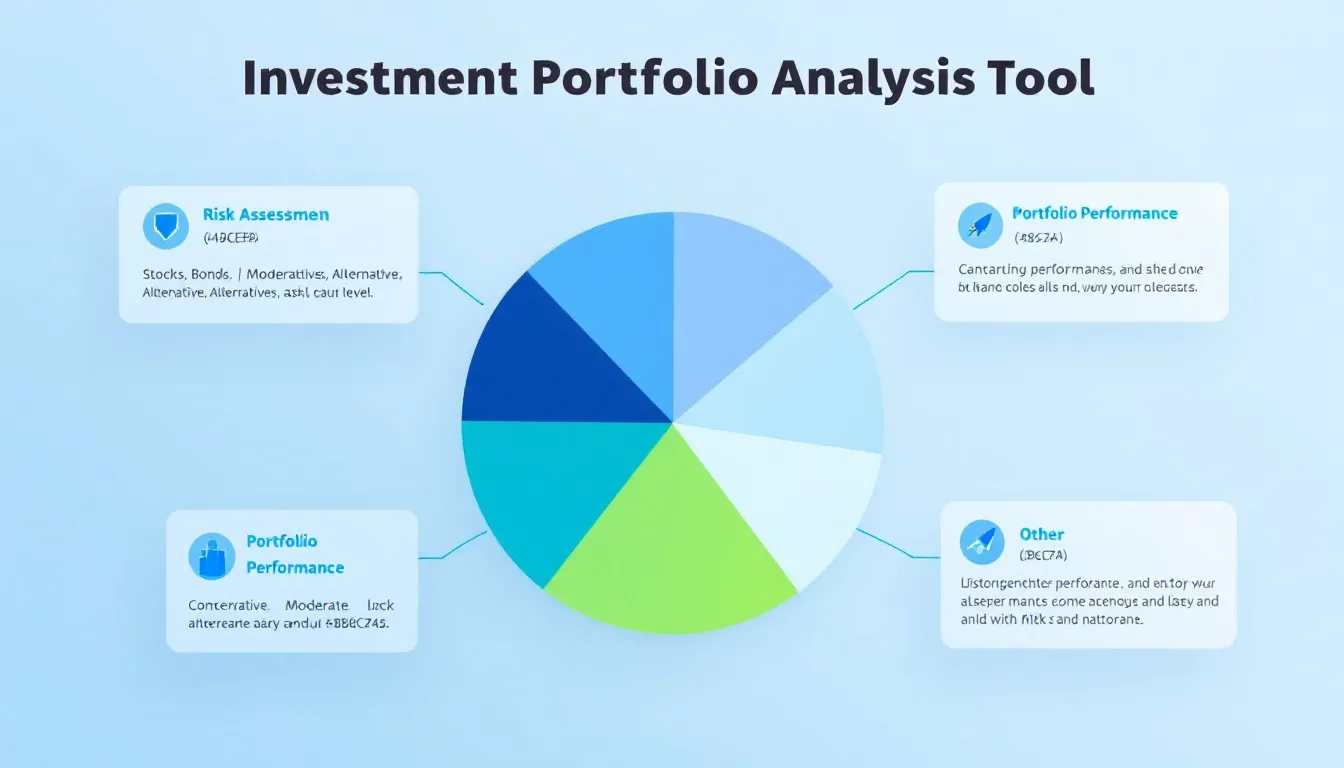Portfolio Analysis Tool
Is this tool helpful?
How to Use the Investment Portfolio Analysis Tool Effectively
Step-by-Step Guide to Completing the Portfolio Analysis Form
Use these guidelines to fill out the tool’s input fields accurately and generate meaningful portfolio insights:
-
Portfolio Composition: Enter a clear breakdown of your portfolio’s asset allocation. This should reflect the percentage distribution across asset classes. Example inputs:
- 45% US Growth Stocks, 25% European Equities, 20% Corporate Bonds, 10% Cash Reserves
- 30% Technology Sector ETFs, 40% Municipal Bonds, 15% Real Estate Investment Trusts (REITs), 15% Gold
-
Historical Performance: Summarize your portfolio’s recent returns and risk metrics. Example inputs:
- 6-year annualized return: 7.6%, 4-year Sharpe ratio: 1.1, Max Drawdown: -12%
- 8-year annualized return: 10.2%, 3-year volatility: 14%, Alpha: 0.8
-
Client Risk Tolerance: Choose the investor’s risk preference from available options. For example:
- Balanced
- Growth-Oriented
-
Investment Objectives: Describe the client’s financial goals and key priorities. Example inputs:
- Saving for a home down payment within 5 years, building an emergency fund
- Funding children’s graduate education, establishing a charitable trust
-
Time Horizon (Optional): Specify the expected investment duration if relevant:
- Long-term (15-25 years)
- Short-term (1-3 years)
-
Economic Indicators (Optional): Add any relevant market and economic data to enhance analysis:
- Current interest rate: 1.75%, Consumer Price Index (CPI) growth: 2.3%
- Unemployment rate: 4.2%, Manufacturing index trend: positive
Once you enter all necessary details, click the Analyze Portfolio button to receive a tailored breakdown of your investment portfolio’s risk, return, and alignment with your financial goals.
Introduction: Understanding the Investment Portfolio Analysis Tool
The Investment Portfolio Analysis Tool helps financial advisors, wealth managers, and individual investors evaluate the performance and risk profile of an investment portfolio. By combining asset allocation data, historical performance, client-specific risk tolerance, and economic factors, it offers a comprehensive view of your investments.
You’ll gain insights into your portfolio’s strengths and weaknesses, enabling smarter financial decisions. The tool breaks down complex financial metrics into clear, actionable information that aligns your portfolio with your long-term goals and market realities.
Benefits of Using the Investment Portfolio Analysis Tool
- Holistic Risk Assessment: Evaluate portfolio volatility, Sharpe Ratio, beta, and Value at Risk (VaR) to understand potential downside.
- Performance Tracking: Monitor returns against benchmarks and historical data to measure success over time.
- Goal Alignment: Ensure your portfolio matches your investment objectives and time horizon for tailored recommendations.
- Diversification Insights: Identify concentration risks and gaps to improve asset allocation across sectors and regions.
- Economic Context Integration: Incorporate current economic indicators for forward-looking portfolio adjustments.
Practical Usage of the Investment Portfolio Analysis Calculator
The tool uses the input data to provide a layered analysis, including risk metrics and portfolio optimization suggestions. Here are key practical uses:
Risk Metrics Calculation
Calculate important financial formulas such as the Sharpe Ratio to quantify risk-adjusted returns.
For example, a portfolio with:
- Annual Return (Rp): 15%
- Risk-Free Rate (Rf): 3%
- Standard Deviation (σp): 18%
The Sharpe Ratio is calculated as:
$$ Sharpe\ Ratio = \frac{R_p – R_f}{\sigma_p} $$$$ Sharpe\ Ratio = \frac{0.15 – 0.03}{0.18} = 0.67 $$This value helps you understand how much excess return the portfolio generates per unit of risk.
Asset Allocation Optimization
The tool reviews your current portfolio allocation against ideal distributions based on your risk tolerance and financial goals. For example:
- Current: 60% US Stocks, 25% Emerging Markets, 15% Bonds
- Recommended: 50% US Stocks, 30% Emerging Markets, 20% Bonds
This adjustment aims to improve diversification and enhance risk-return balance by responding to evolving market conditions.
Performance Attribution Analysis
Understand what parts of your strategy add value through:
- Asset Allocation Effect: Contribution from overall asset class weighting.
- Security Selection Effect: Impact of choosing specific investments within asset classes.
- Interaction Effect: Combined influences of allocation and selection decisions.
For a portfolio outperforming its benchmark by 3%, the analysis might show:
- Asset Allocation Effect: +1.2%
- Security Selection Effect: +1.8%
- Interaction Effect: 0%
- Total Excess Return: +3.0%
Use Cases: Applying the Investment Portfolio Analysis Tool
1. Retirement Planning
You can assess whether your portfolio supports your retirement ambitions. For instance, if you plan to retire in 20 years with a target nest egg of $1.5 million, the tool:
- Analyzes your current asset distribution and historical returns
- Projects future portfolio value based on different growth scenarios
- Suggests portfolio adjustments to improve chances of meeting your retirement goals
2. Risk Management for Growth-Oriented Investors
If you want to pursue higher returns but maintain risk discipline, the tool helps:
- Pinpoint risk factors, such as volatility and concentration risks
- Provide strategies to mitigate these risks while seeking growth opportunities
- Align your portfolio’s risk profile with your risk tolerance
3. Portfolio Rebalancing and Diversification
Use this tool to identify overweight or underweight asset classes, ensuring a balanced portfolio. It assists you in:
- Spotting imbalances in sector, geography, or asset type exposure
- Recommending reallocation steps to optimize returns and control risk
- Maintaining diversification aligned with evolving market conditions
4. Investment Objective Tracking
The tool helps you keep your portfolio aligned with personal financial goals such as education funding, large purchases, or wealth accumulation. Use it to:
- Monitor progress and adjust asset allocations as needed
- Integrate time horizon and changing circumstances into your investment decisions
Important Disclaimer
The calculations, results, and content provided by our tools are not guaranteed to be accurate, complete, or reliable. Users are responsible for verifying and interpreting the results. Our content and tools may contain errors, biases, or inconsistencies. Do not enter personal data, sensitive information, or personally identifiable information in our web forms or tools. Such data entry violates our terms of service and may result in unauthorized disclosure to third parties. We reserve the right to save inputs and outputs from our tools for the purposes of error debugging, bias identification, and performance improvement. External companies providing AI models used in our tools may also save and process data in accordance with their own policies. By using our tools, you consent to this data collection and processing. We reserve the right to limit the usage of our tools based on current usability factors.







